Caprylic Capric Triglycerides Market
Caprylic Capric Triglycerides Market Size and Share Forecast Outlook 2025 to 2035
Caprylic capric triglycerides market is projected to grow from USD 1.1 billion in 2025 to USD 1.9 billion by 2035, at a CAGR of 5.3%. Coconut MCTs will dominate with a 70.0% market share, while cosmetics/skin will lead the application segment with a 50.0% share.
Caprylic Capric Triglycerides Market Forecast and Outlook 2025 to 2035
The global caprylic capric triglycerides market is projected to grow from USD 1.1 billion in 2025 to approximately USD 1.9 billion by 2035, recording an absolute increase of USD 750.0 million over the forecast period. This translates into a total growth of 68.2%, with the market forecast to expand at a CAGR of 5.3% between 2025 and 2035.
The market is expected to grow by nearly 1.7X during the same period, supported by increasing demand for natural-based cosmetic ingredients, growing nutraceutical market expansion, and rising food processing applications requiring specialty triglyceride solutions across various industrial and consumer segments.
Quick Stats for Caprylic Capric Triglycerides Market
- Caprylic Capric Triglycerides Market Value (2025): USD 1.1 billion
- Caprylic Capric Triglycerides Market Forecast Value (2035): USD 1.9 billion
- Caprylic Capric Triglycerides Market CAGR: 5.3%
- Leading Segment by Source (2025) : Coconut MCTs (70.0%)
- Leading Segment by Application (2025): Cosmetics/Skin (50.0%)
- Leading Segment by Form (2025): Liquid (90.0%)
- Key Growth Regions: Asia Pacific, North America, and Europe
- Top Companies by Market Share: Croda, BASF, Emery Oleochemicals
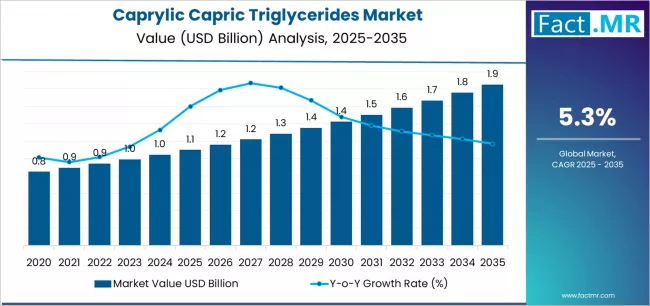
Manufacturing economics reveal significant cost pressures from raw material price volatility, particularly coconut oil pricing fluctuations that directly impact production margins. The market experiences seasonal supply variations tied to coconut harvest cycles in Philippines and Indonesia, creating inventory management challenges for downstream processors. Transportation costs add complexity, as bulk liquid shipments require temperature-controlled logistics, influencing regional pricing structures and favoring local production capabilities where feasible.
Competitive dynamics within the market reflect technological differentiation strategies, where established players like BASF leverage proprietary purification processes to achieve pharmaceutical-grade purity levels. Emery Oleochemicals maintains competitive positioning through integrated production capabilities spanning palm kernel processing to finished triglyceride products. Smaller specialty manufacturers compete through customized formulation services and rapid product development capabilities for niche applications.
Technology adoption patterns influence market structure through process improvements and quality standardization. Molecular distillation techniques enable higher purity levels, commanding premium pricing in pharmaceutical applications.
Continuous processing technologies reduce production costs while improving consistency, benefiting large-scale manufacturers with capital resources for equipment upgrades. Quality control standardization through analytical testing advances supports market expansion by ensuring consistent product specifications across global supply chains.
Regulatory landscapes create market access barriers and opportunities across different regions. European REACH compliance requirements necessitate extensive testing documentation, favoring established suppliers with regulatory expertise over smaller competitors.
Asian markets present varying approval timelines, with Japan requiring detailed safety assessments for cosmetic ingredients while Thailand and Vietnam maintain more streamlined approval processes for food-grade applications.
Manufacturing teams encounter persistent quality control challenges when integrating caprylic capric triglycerides into existing production lines, particularly regarding temperature stability during processing and maintaining consistent viscosity profiles across batch operations.
Procurement departments often clash with quality assurance teams over supplier qualification requirements, as cost-focused buyers prioritize competitive pricing while QA demands extensive documentation for pharmaceutical-grade applications, creating procurement cycle delays that impact production scheduling.
Rising consumer preference for clean-label and naturally derived ingredients is further driving market adoption, particularly in personal care and skincare formulations. Demand for multifunctional triglycerides that provide emollient, moisturizing, and texture-enhancing properties is growing rapidly. This trend encourages product innovation and premiumization, allowing manufacturers to differentiate offerings and capture higher-value segments across cosmetics, nutraceuticals, and specialty food industries.
Caprylic Capric Triglycerides Market Key Takeaways
| Metric | Value |
|---|---|
| Market Value (2025) | USD 1.1 billion |
| Market Forecast Value (2035) | USD 1.9 billion |
| Forecast CAGR (2025-2035) | 5.3% |
Why is the Caprylic Capric Triglycerides Market Growing?
| COSMETIC & PERSONAL CARE DEMAND | NUTRACEUTICAL EXPANSION | FOOD PROCESSING INNOVATION |
|---|---|---|
| Natural Ingredient Preference Consumer shift toward natural and plant-based cosmetic formulations driving demand for coconut and palm-derived triglycerides offering emollient properties and processing advantages. Premium Skincare Applications Growing demand for high-performance skincare ingredients supporting moisture retention, texture enhancement, and product stability in luxury cosmetic formulations. Anti-Aging Product Innovation Advanced anti-aging formulations requiring sophisticated emollient systems with proven performance characteristics and consumer acceptance in premium market segments. | Health Consciousness Growth Expanding nutraceutical sector requiring bioavailable medium-chain triglycerides for dietary supplements and functional food applications with enhanced absorption characteristics. MCT Oil Market Growth Rising popularity of medium-chain triglyceride oils for ketogenic diets and sports nutrition applications creating substantial market opportunities for specialized triglyceride ingredients. Supplement Manufacturing Expanding supplement manufacturing requiring high-quality triglyceride ingredients supporting various delivery systems and nutritional applications. | Specialty Fat Requirements Food processing industry adopting specialty triglycerides for texture modification, shelf-life extension, and performance enhancement in processed food manufacturing. Processing Efficiency Benefits Manufacturing operations seeking processing-efficient ingredients offering consistent performance, stability, and cost-effective production capabilities. Clean Label Requirements Consumer demand for clean-label food products driving adoption of natural triglyceride ingredients meeting transparency and quality standards. |
Caprylic Capric Triglycerides Market Segmentation
| Category | Segments Covered |
|---|---|
| By Source | Coconut MCTs, Palm MCTs |
| By Application | Cosmetics/Skin, Nutraceuticals, Food |
| By Form | Liquid, Emulsion |
| By Region | North America, Europe, Asia Pacific, Latin America, Middle East & Africa |
Caprylic Capric Triglycerides Market Analysis by Source
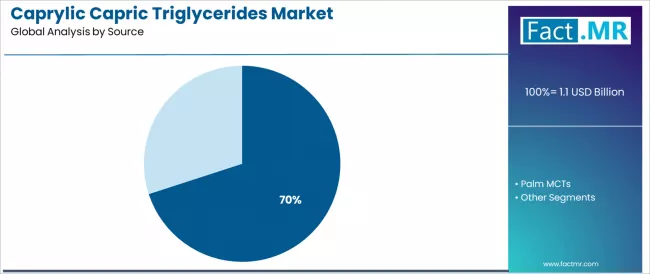
| Segment | 2025 to 2035 Outlook |
|---|---|
| Coconut MCTs | Leader in 2025 with 70.0% market share; likely to maintain leadership through 2035. Established supply chains, proven performance characteristics, consumer preference for coconut-derived ingredients. Momentum: steady-to-strong. Watchouts: raw material price volatility, supply chain constraints. |
| Palm MCTs | Cost-effective alternative for industrial applications, but sustainability concerns limit adoption in premium consumer segments. Growing in price-sensitive applications. Momentum: steady in industrial segments; pressure in consumer applications. |
Caprylic Capric Triglycerides Market Analysis by Application
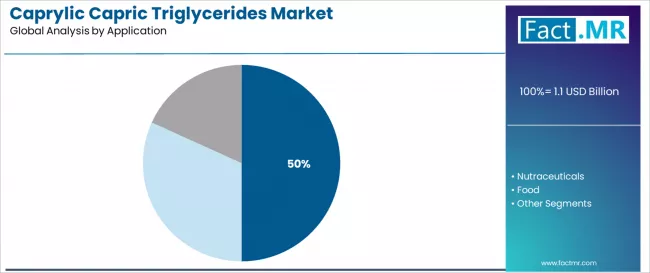
| Segment | 2025 to 2035 Outlook |
|---|---|
| Cosmetics/Skin | At 50.0%, largest application segment in 2025 with established integration in skincare, makeup, and personal care products. Mature supply chains, proven formulation benefits. Momentum: steady growth driven by natural cosmetics trend and premium skincare demand. Watchouts: regulatory changes affecting cosmetic formulations. |
| Nutraceuticals | Strong growth segment at 25.0% driven by MCT oil popularity, ketogenic diet adoption, and sports nutrition applications. Growing consumer awareness of medium-chain triglyceride benefits. Momentum: strong growth through 2030, supported by health and wellness trends. Watchouts: competition from alternative nutrient delivery systems. |
| Food | Specialized segment at 25.0% with diverse applications in processed foods, bakery products, and specialty formulations. Growing demand for natural food ingredients and clean-label solutions. Momentum: moderate growth via food innovation and natural ingredient adoption. Watchouts: regulatory requirements affecting food processing applications. |
Caprylic Capric Triglycerides Market Analysis by Form
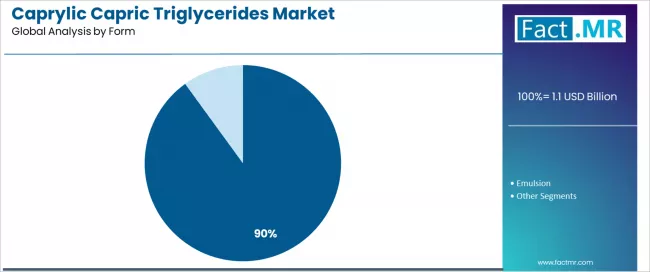
| Form | Status & Outlook 2025-2035 |
|---|---|
| Liquid | Dominant form in 2025 with 90.0% share across cosmetic, nutraceutical, and food applications. Processing advantages, ease of handling, versatile application properties. Momentum: steady growth driven by manufacturing efficiency and application versatility. Watchouts: temperature sensitivity in certain conditions. |
| Emulsion | Specialized form for specific applications requiring enhanced stability and controlled release properties. Value-add through improved performance characteristics. Momentum: moderate growth as specialty applications demand enhanced properties. Processing complexity may limit broader adoption. |
DRIVERS
| DRIVERS | RESTRAINTS | KEY TRENDS |
|---|---|---|
| Natural Ingredient Demand Growing consumer preference for natural and plant-based ingredients across cosmetic, nutraceutical, and food applications driving demand for coconut and palm-derived triglycerides. Health and Wellness Trends Expanding health consciousness creating demand for bioavailable medium-chain triglycerides in dietary supplements, functional foods, and wellness applications. Premium Cosmetic Growth Growing demand for high-performance cosmetic ingredients supporting luxury skincare formulations, anti-aging products, and specialty personal care applications. Food Processing Innovation Food industry adoption of specialty triglycerides for texture modification, shelf-life enhancement, and performance optimization in processed food manufacturing. | Raw Material Price Volatility Price fluctuations in coconut and palm oil affecting production costs and supply chain predictability for manufacturers and formulators. Supply Chain Constraints Limited production capacity and geographic concentration of raw material sources affecting supply reliability and cost management. Regulatory Complexity Complex regulatory requirements across applications affecting product development, approval timelines, and market access strategies. Competition from Alternatives Alternative ingredient technologies and synthetic substitutes affecting market selection and competitive positioning. | Clean Beauty Movement Integration of natural triglyceride ingredients in clean beauty formulations, transparent labeling, and premium positioning strategies. MCT Oil Popularity Rising adoption of medium-chain triglyceride oils for ketogenic diets, sports nutrition, and cognitive health applications. Processing Innovation Advanced processing technologies enabling enhanced purity, improved performance characteristics, and specialized grade development. Application Diversification Expanding applications across industries including pharmaceuticals, specialty chemicals, and industrial processing sectors. |
Analysis of Caprylic Capric Triglycerides Market by Key Countries
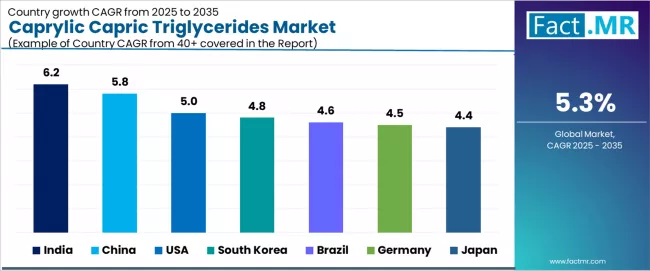
| Country | CAGR (2025-2035) |
|---|---|
| India | 6.2% |
| China | 5.8% |
| South Korea | 4.8% |
| Brazil | 4.6% |
| Germany | 4.5% |
| Japan | 4.4% |
| USA | 5.0% |
India Leads Global Market Growth with Cosmetic Excellence
Revenue from caprylic capric triglycerides in India is projected to exhibit strong growth driven by expanding cosmetic manufacturing infrastructure and comprehensive personal care industry innovation creating substantial opportunities for ingredient suppliers across skincare operations, nutraceutical applications, and specialty food sectors.
The country's developing beauty manufacturing tradition and expanding consumer awareness capabilities are creating significant demand for both conventional and premium triglyceride ingredients. Major cosmetic companies are establishing comprehensive local processing facilities to support large-scale manufacturing operations and meet growing demand for natural ingredient solutions.
- Cosmetic industry modernization programs are supporting widespread adoption of natural triglyceride processing across manufacturing operations, driving demand for high-quality coconut and palm-derived ingredients
- Personal care manufacturing excellence initiatives and specialized product development are creating substantial opportunities for ingredient suppliers requiring reliable performance and cost-effective triglyceride solutions
- Beauty product manufacturing growth and cosmetic processing development are facilitating adoption of specialty triglyceride ingredients throughout major industrial regions
China Demonstrates Strong Market Potential with Manufacturing Growth
Revenue from caprylic capric triglycerides in China is expanding supported by extensive cosmetic manufacturing expansion and comprehensive personal care industry development creating demand for reliable triglyceride ingredients across diverse manufacturing categories and specialty consumer segments.
The country's dominant cosmetic production position and expanding manufacturing capabilities are driving demand for triglyceride solutions that provide consistent performance while supporting cost-effective processing requirements. Personal care processors and manufacturers are investing in local production facilities to support growing manufacturing operations and consumer product demand.
- Cosmetic manufacturing operations expansion and personal care processing capability development are creating opportunities for triglyceride ingredients across diverse manufacturing segments requiring reliable performance and competitive processing costs
- Manufacturing modernization and processing technology advancement are driving investments in ingredient supply chains supporting performance requirements throughout major industrial regions
- Personal care manufacturing growth and specialty product development programs are enhancing demand for processing-grade triglycerides throughout cosmetic production areas
USA Maintains Strong Position with Premium Innovation
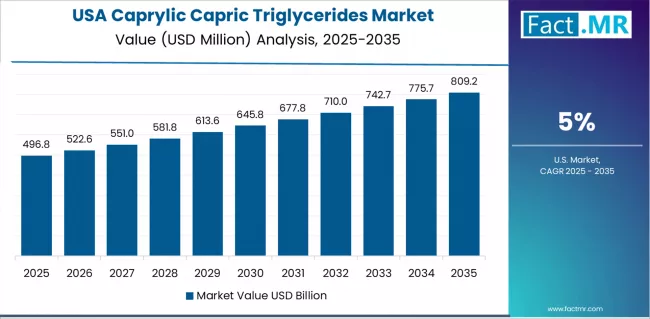
Demand for caprylic capric triglycerides in USA is projected to grow supported by the country's expanding cosmetic manufacturing base and nutraceutical processing technologies requiring advanced triglyceride systems for skincare production and dietary supplement applications.
American companies are implementing processing systems that support advanced manufacturing techniques, operational efficiency, and comprehensive quality protocols. The market is characterized by focus on operational excellence, performance optimization, and compliance with cosmetic and food safety standards.
- Premium cosmetic industry investments are prioritizing advanced processing technologies that demonstrate superior performance and quality while meeting American manufacturing standards
- Nutraceutical processing leadership programs and operational excellence initiatives are driving adoption of precision-engineered triglyceride ingredients that support advanced manufacturing systems and performance optimization
- Research and development programs for natural ingredient enhancement are facilitating adoption of specialized processing techniques throughout major cosmetic and nutraceutical centers
Germany Focuses on Premium Manufacturing
Demand for caprylic capric triglycerides in Germany is projected to grow driven by premium cosmetic manufacturing excellence and specialty triglyceride capabilities supporting advanced product development and comprehensive personal care applications.
The country's established cosmetic processing tradition and growing performance product market segments are creating demand for high-quality triglyceride ingredients that support operational performance and quality standards. Cosmetic manufacturers and processing suppliers are maintaining comprehensive development capabilities to support diverse manufacturing requirements.
- Premium cosmetic manufacturing and specialty triglyceride programs are supporting demand for processing-grade caprylic capric triglycerides that meet contemporary performance and reliability standards
- Personal care product development and performance-focused manufacturing programs are creating opportunities for specialized triglyceride ingredients that provide comprehensive formulation support
- Manufacturing modernization and quality enhancement programs are facilitating adoption of advanced processing capabilities throughout major cosmetic regions
Japan Focuses on Precision Manufacturing

Demand for caprylic capric triglycerides in Japan is projected to grow driven by precision cosmetic manufacturing excellence and specialty triglyceride capabilities supporting advanced product development and comprehensive technical applications.
The country's established cosmetic processing tradition and growing performance product market segments are creating demand for high-quality triglyceride ingredients that support operational performance and quality standards.
- Precision cosmetic manufacturing and specialty triglyceride programs are supporting demand for processing-grade caprylic capric triglycerides that meet contemporary performance and reliability standards
- Product development and performance-focused manufacturing programs are creating opportunities for specialized triglyceride ingredients that provide comprehensive formulation support
- Manufacturing modernization and quality enhancement programs are facilitating adoption of advanced processing capabilities throughout major cosmetic regions
South Korea Focuses on Advanced Beauty Manufacturing

Demand for caprylic capric triglycerides in South Korea is projected to grow at 4.8% CAGR driven by advanced beauty manufacturing excellence and specialty triglyceride capabilities supporting product development and comprehensive cosmetic applications.
The country's established cosmetic processing tradition and growing K-beauty market segments are creating demand for high-quality triglyceride ingredients that support operational performance and quality standards.
- Advanced beauty manufacturing and specialty triglyceride programs are supporting demand for processing-grade caprylic capric triglycerides that meet contemporary performance and reliability standards
- Cosmetic development and performance-focused manufacturing programs are creating opportunities for specialized triglyceride ingredients that provide comprehensive formulation support
- Manufacturing modernization and quality enhancement programs are facilitating adoption of advanced processing capabilities throughout major beauty regions
Brazil Focuses on Natural Ingredient Processing
Demand for caprylic capric triglycerides in Brazil is projected to grow driven by natural cosmetic manufacturing excellence and specialty triglyceride capabilities supporting advanced product development and comprehensive personal care applications.
The country's established natural ingredient processing tradition and growing organic product market segments are creating demand for high-quality triglyceride ingredients that support operational performance and quality standards.
- Natural cosmetic manufacturing and specialty triglyceride programs are supporting demand for processing-grade caprylic capric triglycerides that meet contemporary performance and reliability standards
- Personal care product development and performance-focused manufacturing programs are creating opportunities for specialized triglyceride ingredients that provide comprehensive formulation support
- Manufacturing modernization and quality enhancement programs are facilitating adoption of advanced processing capabilities throughout major cosmetic regions
Europe Market Split by Processing Application
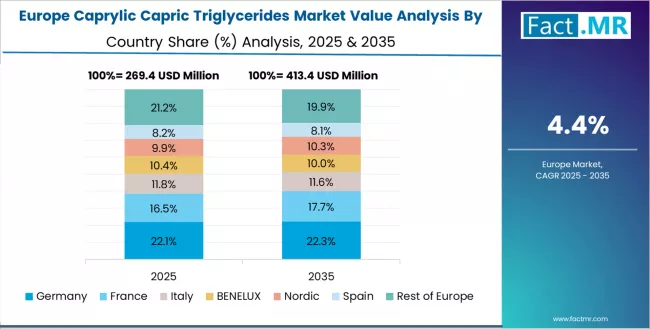
The caprylic capric triglycerides (MCT) market in Europe is increasingly characterized by a dual dynamic: Western European precision processing versus Eastern European cost-competitive manufacturing. Germany (USD 230.0 million) and the UK (USD 170.0 million) lead in premium cosmetic and nutraceutical triglyceride production, leveraging advanced cosmetic technologies, stringent quality protocols, and technical specifications set by major cosmetic companies. These factors enable processors to command price premiums in global markets, with German operations maintaining leadership in high-performance triglyceride applications.
France (USD 150.0 million), Italy (USD 120.0 million), and Spain (USD 100.0 million) focus on specialized applications tailored to regional market needs. In contrast, Eastern European operations—including Poland, Hungary, and the Czech Republic—capture volume-driven processing contracts by capitalizing on labor cost advantages and adherence to EU regulatory standards, particularly for standard triglyceride ingredients used in cosmetics. Overall, the Rest of Europe contributes USD 330.0 million to the market.
Regulatory frameworks present both challenges and opportunities. EU cosmetic regulations and novel food directives impose high entry barriers for new triglyceride ingredients while favoring established European processors capable of demonstrating full compliance. Meanwhile, Brexit has altered supply dynamics, creating opportunities for direct relationships between UK cosmetic manufacturers and non-EU suppliers.
Supply chain consolidation is accelerating as processors pursue economies of scale to offset rising energy costs and compliance expenses. Vertical integration is also increasing, with major cosmetic companies acquiring processing facilities to secure supply and maintain quality control. Smaller processors face mounting pressure to specialize in niche applications or risk being outcompeted by larger, more efficient operations serving mainstream cosmetic manufacturing needs.
Premium Quality Standards Define Japanese Market Dynamics
Japan’s caprylic capric triglycerides (MCT) market is shaped by the country’s exacting quality standards and highly sophisticated cosmetic industry. Leading cosmetic manufacturers enforce rigorous supplier qualification processes that frequently exceed international norms, including extensive documentation, batch testing, and facility audits that can span 12–18 months. These high entry barriers ensure consistent product quality, reinforcing the premium positioning of Japanese cosmetics.
The market exhibits distinct application preferences: Cosmetics account for 60.0%, Nutraceuticals 20.0%, and Food 20.0%. Companies demand purity levels and performance characteristics tailored to local expectations, necessitating customized processing capabilities that differ from Western requirements. Source preferences are similarly specific, with Coconut-derived MCTs representing 75.0% and Palm-derived MCTs 25.0%. Suppliers must meet defined molecular properties and sustainability standards to align with market expectations.
Regulatory oversight is stringent, emphasizing comprehensive cosmetic ingredient management, traceability, and detailed ingredient disclosure. The Japanese cosmetic registration system often surpasses international standards, favoring suppliers with transparent supply chains and robust documentation systems.
Supply chain management in Japan is predominantly relationship driven. Companies maintain long-term partnerships with suppliers, often spanning decades, with annual contract reviews focusing on quality consistency rather than price competition. This stability supports investments in specialized processing equipment and ensures reliable delivery of grades that meet Japan-specific specifications.
Market Dynamics Drive Innovation in South Korea
South Korea’s caprylic capric triglycerides (MCT) sector reflects the country’s advanced beauty manufacturing ecosystem and its export-driven business model. Leading cosmetic companies implement sophisticated procurement strategies, forging direct relationships with global suppliers to secure consistent quality, traceable sourcing, and stable pricing for skincare and personal care products aimed at both domestic and international markets.
The market exhibits a clear application focus: Cosmetics represent 65.0%, Nutraceuticals 25.0%, and Food 10.0%. This beauty-centric orientation drives demand for performance-specific grades that often diverge from Western specifications, requiring suppliers to optimize processing, purification, and formulation techniques.
Source preferences are equally distinctive: Coconut-derived MCTs account for 75.0% of supply, while Palm-derived MCTs make up 25.0%, reflecting both functional and market-driven considerations. Sustainability credentials, traceability, and alignment with K-beauty standards are increasingly critical, creating demand for premium sourcing and compliant production practices.
Regulatory oversight, particularly by the Korean Food and Drug Administration, emphasizes ingredient safety, traceability, and rigorous documentation—often exceeding international norms. While this creates entry barriers for smaller suppliers, it benefits established processors capable of demonstrating full compliance through comprehensive certifications and transparent quality systems.
Given South Korea’s geographic constraints and import reliance, supply chain efficiency remains a strategic priority. Companies are securing long-term contracts with suppliers in the United States, Germany, and Malaysia to ensure reliable raw material access while managing foreign exchange exposure. Investments in technical logistics and cold-chain management further safeguard product integrity during extended transport.
The market is navigating rising labor costs and competitive pressures from lower-cost regional producers, prompting automation upgrades and consolidation among smaller processors. Nonetheless, the global premium positioning of Korean beauty brands continues to sustain robust demand for high-quality caprylic capric triglycerides, particularly those meeting stringent performance and certification standards.
Competitive Landscape of Caprylic Capric Triglycerides Market
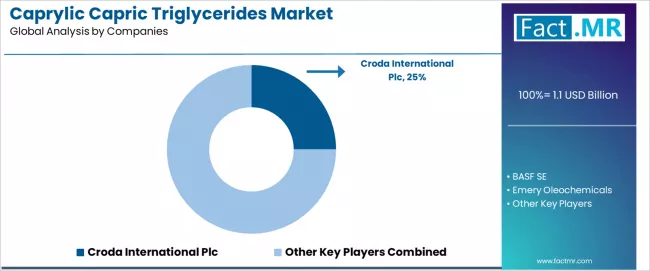
Profit pools in the triglycerides market are increasingly consolidating both upstream, through large-scale production systems, and downstream, where value-added specialty grades for cosmetics, nutraceuticals, and food applications command premium pricing. In these segments, certification, purity, and consistent performance are critical differentiators. The industry is witnessing a pronounced shift: value is moving away from commodity triglyceride trading toward specification-tight, application-ready ingredients, where technical expertise, formulation support, and rigorous quality control define competitive advantage.
Several industry archetypes are shaping this evolution: global oleochemical integrators leverage scale and operational reliability to defend market share; multi-grade processors manage complexity and deliver across diverse applications; specialty triglyceride developers excel through formulation knowledge and established industry relationships; and performance-driven suppliers capture premium volumes in high-value cosmetic and nutraceutical markets. Switching costs, such as re-qualification, performance validation, and formulation testing, create defensibility for incumbents, while supply disruptions, regulatory changes, and emerging end-use trends periodically open opportunities for agile, diversified players.
Market consolidation and vertical integration remain prominent, though digital procurement platforms are gaining traction in commodity-grade transactions, whereas premium and application-specific grades continue to rely on close supplier-customer relationships. Strategic priorities for market participants include securing cosmetic and nutraceutical pipelines through tailored grades and service-level agreements, building multi-grade production capabilities with transparent technical disclosures, and innovating specialized triglyceride formulations backed by demonstrable performance claims.
| Stakeholder Type | Primary Advantage | Repeatable Plays |
|---|---|---|
| Global oleochemical integrators | Scale, production integration, technical reliability | Long-term contracts, tight specs, co-development with cosmetics/nutraceuticals |
| Multi-grade processors | Grade diversification, application expertise, supply flexibility | Multi-application serving, technical support, quality assurance across segments |
| Specialty triglyceride developers | Formulation expertise and industry relationships | Custom grades, performance science, application SLAs |
| Performance suppliers | Application-focused demand and specialized service | Technical performance claims, specialized grades, application activation |
| Ingredient distributors & platforms | Technical support for mid-tier manufacturers | Grade selection, smaller volumes, technical service |
Key Players in the Caprylic Capric Triglycerides Market
- Croda International Plc
- BASF SE
- Emery Oleochemicals
- IOI Oleochemical Industries Berhad
- KLK Oleo
- Stepan Company
- Wilmar International Limited
- Vantage Specialty Ingredients
- ABITEC Corporation
- Capchem Technology Co., Ltd.
- Koura Global
- Oleon NV
- MCT Corporation
Scope of the Report
| Items | Values |
|---|---|
| Quantitative Units (2025) | USD 1.1 billion |
| Source | Coconut MCTs, Palm MCTs |
| Application | Cosmetics/Skin, Nutraceuticals, Food |
| Form | Liquid, Emulsion |
| Regions Covered | North America, Europe, Asia Pacific, Latin America, Middle East & Africa |
| Countries Covered | United States, Germany, China, Japan, India, South Korea, Brazil, and other 40+ countries |
| Key Companies Profiled | Croda, BASF, Emery Oleochemicals, IOI Oleo, KLK Oleo, Stepan, Wilmar, Vantage, ABITEC, Capchem, Koura, Oleon, MCT Corp |
| Additional Attributes | Dollar sales by source/application/form, regional demand (NA, EU, APAC), competitive landscape, liquid vs. emulsion adoption, production/processing integration, and advanced processing innovations driving purity enhancement, technical advancement, and efficiency |
Caprylic Capric Triglycerides Market Segmentation
-
By Source
- Coconut MCTs
- Palm MCTs
-
By Application
- Cosmetics/Skin
- Nutraceuticals
- Food
-
By Form
- Liquid
- Emulsion
-
By Region
- North America
- Europe
- Asia Pacific
- Latin America
- Middle East & Africa
Table of Content
- Executive Summary
- Global Market Outlook
- Demand to side Trends
- Supply to side Trends
- Technology Roadmap Analysis
- Analysis and Recommendations
- Market Overview
- Market Coverage / Taxonomy
- Market Definition / Scope / Limitations
- Market Background
- Market Dynamics
- Drivers
- Restraints
- Opportunity
- Trends
- Scenario Forecast
- Demand in Optimistic Scenario
- Demand in Likely Scenario
- Demand in Conservative Scenario
- Opportunity Map Analysis
- Product Life Cycle Analysis
- Supply Chain Analysis
- Investment Feasibility Matrix
- Value Chain Analysis
- PESTLE and Porter’s Analysis
- Regulatory Landscape
- Regional Parent Market Outlook
- Production and Consumption Statistics
- Import and Export Statistics
- Market Dynamics
- Global Market Analysis 2020 to 2024 and Forecast, 2025 to 2035
- Historical Market Size Value (USD Million) Analysis, 2020 to 2024
- Current and Future Market Size Value (USD Million) Projections, 2025 to 2035
- Y to o to Y Growth Trend Analysis
- Absolute $ Opportunity Analysis
- Global Market Pricing Analysis 2020 to 2024 and Forecast 2025 to 2035
- Global Market Analysis 2020 to 2024 and Forecast 2025 to 2035, By Source
- Introduction / Key Findings
- Historical Market Size Value (USD Million) Analysis By Source , 2020 to 2024
- Current and Future Market Size Value (USD Million) Analysis and Forecast By Source , 2025 to 2035
- Coconut MCTs
- Palm MCTs
- Y to o to Y Growth Trend Analysis By Source , 2020 to 2024
- Absolute $ Opportunity Analysis By Source , 2025 to 2035
- Global Market Analysis 2020 to 2024 and Forecast 2025 to 2035, By Application
- Introduction / Key Findings
- Historical Market Size Value (USD Million) Analysis By Application, 2020 to 2024
- Current and Future Market Size Value (USD Million) Analysis and Forecast By Application, 2025 to 2035
- Cosmetics/Skin
- Nutraceuticals
- Food
- Y to o to Y Growth Trend Analysis By Application, 2020 to 2024
- Absolute $ Opportunity Analysis By Application, 2025 to 2035
- Global Market Analysis 2020 to 2024 and Forecast 2025 to 2035, By Form
- Introduction / Key Findings
- Historical Market Size Value (USD Million) Analysis By Form, 2020 to 2024
- Current and Future Market Size Value (USD Million) Analysis and Forecast By Form, 2025 to 2035
- Liquid
- Emulsion
- Y to o to Y Growth Trend Analysis By Form, 2020 to 2024
- Absolute $ Opportunity Analysis By Form, 2025 to 2035
- Global Market Analysis 2020 to 2024 and Forecast 2025 to 2035, By Region
- Introduction
- Historical Market Size Value (USD Million) Analysis By Region, 2020 to 2024
- Current Market Size Value (USD Million) Analysis and Forecast By Region, 2025 to 2035
- North America
- Latin America
- Western Europe
- Eastern Europe
- East Asia
- South Asia and Pacific
- Middle East & Africa
- Market Attractiveness Analysis By Region
- North America Market Analysis 2020 to 2024 and Forecast 2025 to 2035, By Country
- Historical Market Size Value (USD Million) Trend Analysis By Market Taxonomy, 2020 to 2024
- Market Size Value (USD Million) Forecast By Market Taxonomy, 2025 to 2035
- By Country
- USA
- Canada
- Mexico
- By Source
- By Application
- By Form
- By Country
- Market Attractiveness Analysis
- By Country
- By Source
- By Application
- By Form
- Key Takeaways
- Latin America Market Analysis 2020 to 2024 and Forecast 2025 to 2035, By Country
- Historical Market Size Value (USD Million) Trend Analysis By Market Taxonomy, 2020 to 2024
- Market Size Value (USD Million) Forecast By Market Taxonomy, 2025 to 2035
- By Country
- Brazil
- Chile
- Rest of Latin America
- By Source
- By Application
- By Form
- By Country
- Market Attractiveness Analysis
- By Country
- By Source
- By Application
- By Form
- Key Takeaways
- Western Europe Market Analysis 2020 to 2024 and Forecast 2025 to 2035, By Country
- Historical Market Size Value (USD Million) Trend Analysis By Market Taxonomy, 2020 to 2024
- Market Size Value (USD Million) Forecast By Market Taxonomy, 2025 to 2035
- By Country
- Germany
- UK
- Italy
- Spain
- France
- Nordic
- BENELUX
- Rest of Western Europe
- By Source
- By Application
- By Form
- By Country
- Market Attractiveness Analysis
- By Country
- By Source
- By Application
- By Form
- Key Takeaways
- Eastern Europe Market Analysis 2020 to 2024 and Forecast 2025 to 2035, By Country
- Historical Market Size Value (USD Million) Trend Analysis By Market Taxonomy, 2020 to 2024
- Market Size Value (USD Million) Forecast By Market Taxonomy, 2025 to 2035
- By Country
- Russia
- Poland
- Hungary
- Balkan & Baltic
- Rest of Eastern Europe
- By Source
- By Application
- By Form
- By Country
- Market Attractiveness Analysis
- By Country
- By Source
- By Application
- By Form
- Key Takeaways
- East Asia Market Analysis 2020 to 2024 and Forecast 2025 to 2035, By Country
- Historical Market Size Value (USD Million) Trend Analysis By Market Taxonomy, 2020 to 2024
- Market Size Value (USD Million) Forecast By Market Taxonomy, 2025 to 2035
- By Country
- China
- Japan
- South Korea
- By Source
- By Application
- By Form
- By Country
- Market Attractiveness Analysis
- By Country
- By Source
- By Application
- By Form
- Key Takeaways
- South Asia and Pacific Market Analysis 2020 to 2024 and Forecast 2025 to 2035, By Country
- Historical Market Size Value (USD Million) Trend Analysis By Market Taxonomy, 2020 to 2024
- Market Size Value (USD Million) Forecast By Market Taxonomy, 2025 to 2035
- By Country
- India
- ASEAN
- Australia & New Zealand
- Rest of South Asia and Pacific
- By Source
- By Application
- By Form
- By Country
- Market Attractiveness Analysis
- By Country
- By Source
- By Application
- By Form
- Key Takeaways
- Middle East & Africa Market Analysis 2020 to 2024 and Forecast 2025 to 2035, By Country
- Historical Market Size Value (USD Million) Trend Analysis By Market Taxonomy, 2020 to 2024
- Market Size Value (USD Million) Forecast By Market Taxonomy, 2025 to 2035
- By Country
- Kingdom of Saudi Arabia
- Other GCC Countries
- Turkiye
- South Africa
- Other African Union
- Rest of Middle East & Africa
- By Source
- By Application
- By Form
- By Country
- Market Attractiveness Analysis
- By Country
- By Source
- By Application
- By Form
- Key Takeaways
- Key Countries Market Analysis
- USA
- Pricing Analysis
- Market Share Analysis, 2024
- By Source
- By Application
- By Form
- Canada
- Pricing Analysis
- Market Share Analysis, 2024
- By Source
- By Application
- By Form
- Mexico
- Pricing Analysis
- Market Share Analysis, 2024
- By Source
- By Application
- By Form
- Brazil
- Pricing Analysis
- Market Share Analysis, 2024
- By Source
- By Application
- By Form
- Chile
- Pricing Analysis
- Market Share Analysis, 2024
- By Source
- By Application
- By Form
- Germany
- Pricing Analysis
- Market Share Analysis, 2024
- By Source
- By Application
- By Form
- UK
- Pricing Analysis
- Market Share Analysis, 2024
- By Source
- By Application
- By Form
- Italy
- Pricing Analysis
- Market Share Analysis, 2024
- By Source
- By Application
- By Form
- Spain
- Pricing Analysis
- Market Share Analysis, 2024
- By Source
- By Application
- By Form
- France
- Pricing Analysis
- Market Share Analysis, 2024
- By Source
- By Application
- By Form
- India
- Pricing Analysis
- Market Share Analysis, 2024
- By Source
- By Application
- By Form
- ASEAN
- Pricing Analysis
- Market Share Analysis, 2024
- By Source
- By Application
- By Form
- Australia & New Zealand
- Pricing Analysis
- Market Share Analysis, 2024
- By Source
- By Application
- By Form
- China
- Pricing Analysis
- Market Share Analysis, 2024
- By Source
- By Application
- By Form
- Japan
- Pricing Analysis
- Market Share Analysis, 2024
- By Source
- By Application
- By Form
- South Korea
- Pricing Analysis
- Market Share Analysis, 2024
- By Source
- By Application
- By Form
- Russia
- Pricing Analysis
- Market Share Analysis, 2024
- By Source
- By Application
- By Form
- Poland
- Pricing Analysis
- Market Share Analysis, 2024
- By Source
- By Application
- By Form
- Hungary
- Pricing Analysis
- Market Share Analysis, 2024
- By Source
- By Application
- By Form
- Kingdom of Saudi Arabia
- Pricing Analysis
- Market Share Analysis, 2024
- By Source
- By Application
- By Form
- Turkiye
- Pricing Analysis
- Market Share Analysis, 2024
- By Source
- By Application
- By Form
- South Africa
- Pricing Analysis
- Market Share Analysis, 2024
- By Source
- By Application
- By Form
- USA
- Market Structure Analysis
- Competition Dashboard
- Competition Benchmarking
- Market Share Analysis of Top Players
- By Regional
- By Source
- By Application
- By Form
- Competition Analysis
- Competition Deep Dive
- Croda International Plc
- Overview
- Product Portfolio
- Profitability by Market Segments (Product/Age /Sales Channel/Region)
- Sales Footprint
- Strategy Overview
- Marketing Strategy
- Product Strategy
- Channel Strategy
- BASF SE
- Emery Oleochemicals
- IOI Oleochemical Industries Berhad
- KLK Oleo
- Stepan Company
- Wilmar International Limited
- Vantage Specialty Ingredients
- ABITEC Corporation
- Capchem Technology Co., Ltd.
- Koura Global
- Oleon NV
- MCT Corporation
- Croda International Plc
- Competition Deep Dive
- Assumptions & Acronyms Used
- Research Methodology
List Of Table
- Table 1: Global Market Value (USD Million) Forecast by Region, 2020 to 2035
- Table 2: Global Market Value (USD Million) Forecast by Source , 2020 to 2035
- Table 3: Global Market Value (USD Million) Forecast by Application, 2020 to 2035
- Table 4: Global Market Value (USD Million) Forecast by Form, 2020 to 2035
- Table 5: North America Market Value (USD Million) Forecast by Country, 2020 to 2035
- Table 6: North America Market Value (USD Million) Forecast by Source , 2020 to 2035
- Table 7: North America Market Value (USD Million) Forecast by Application, 2020 to 2035
- Table 8: North America Market Value (USD Million) Forecast by Form, 2020 to 2035
- Table 9: Latin America Market Value (USD Million) Forecast by Country, 2020 to 2035
- Table 10: Latin America Market Value (USD Million) Forecast by Source , 2020 to 2035
- Table 11: Latin America Market Value (USD Million) Forecast by Application, 2020 to 2035
- Table 12: Latin America Market Value (USD Million) Forecast by Form, 2020 to 2035
- Table 13: Western Europe Market Value (USD Million) Forecast by Country, 2020 to 2035
- Table 14: Western Europe Market Value (USD Million) Forecast by Source , 2020 to 2035
- Table 15: Western Europe Market Value (USD Million) Forecast by Application, 2020 to 2035
- Table 16: Western Europe Market Value (USD Million) Forecast by Form, 2020 to 2035
- Table 17: Eastern Europe Market Value (USD Million) Forecast by Country, 2020 to 2035
- Table 18: Eastern Europe Market Value (USD Million) Forecast by Source , 2020 to 2035
- Table 19: Eastern Europe Market Value (USD Million) Forecast by Application, 2020 to 2035
- Table 20: Eastern Europe Market Value (USD Million) Forecast by Form, 2020 to 2035
- Table 21: East Asia Market Value (USD Million) Forecast by Country, 2020 to 2035
- Table 22: East Asia Market Value (USD Million) Forecast by Source , 2020 to 2035
- Table 23: East Asia Market Value (USD Million) Forecast by Application, 2020 to 2035
- Table 24: East Asia Market Value (USD Million) Forecast by Form, 2020 to 2035
- Table 25: South Asia and Pacific Market Value (USD Million) Forecast by Country, 2020 to 2035
- Table 26: South Asia and Pacific Market Value (USD Million) Forecast by Source , 2020 to 2035
- Table 27: South Asia and Pacific Market Value (USD Million) Forecast by Application, 2020 to 2035
- Table 28: South Asia and Pacific Market Value (USD Million) Forecast by Form, 2020 to 2035
- Table 29: Middle East & Africa Market Value (USD Million) Forecast by Country, 2020 to 2035
- Table 30: Middle East & Africa Market Value (USD Million) Forecast by Source , 2020 to 2035
- Table 31: Middle East & Africa Market Value (USD Million) Forecast by Application, 2020 to 2035
- Table 32: Middle East & Africa Market Value (USD Million) Forecast by Form, 2020 to 2035
List Of Figures
- Figure 1: Global Market Pricing Analysis
- Figure 2: Global Market Value (USD Million) Forecast 2020-2035
- Figure 3: Global Market Value Share and BPS Analysis by Source , 2025 and 2035
- Figure 4: Global Market Y to o to Y Growth Comparison by Source , 2025-2035
- Figure 5: Global Market Attractiveness Analysis by Source
- Figure 6: Global Market Value Share and BPS Analysis by Application, 2025 and 2035
- Figure 7: Global Market Y to o to Y Growth Comparison by Application, 2025-2035
- Figure 8: Global Market Attractiveness Analysis by Application
- Figure 9: Global Market Value Share and BPS Analysis by Form, 2025 and 2035
- Figure 10: Global Market Y to o to Y Growth Comparison by Form, 2025-2035
- Figure 11: Global Market Attractiveness Analysis by Form
- Figure 12: Global Market Value (USD Million) Share and BPS Analysis by Region, 2025 and 2035
- Figure 13: Global Market Y to o to Y Growth Comparison by Region, 2025-2035
- Figure 14: Global Market Attractiveness Analysis by Region
- Figure 15: North America Market Incremental Dollar Opportunity, 2025-2035
- Figure 16: Latin America Market Incremental Dollar Opportunity, 2025-2035
- Figure 17: Western Europe Market Incremental Dollar Opportunity, 2025-2035
- Figure 18: Eastern Europe Market Incremental Dollar Opportunity, 2025-2035
- Figure 19: East Asia Market Incremental Dollar Opportunity, 2025-2035
- Figure 20: South Asia and Pacific Market Incremental Dollar Opportunity, 2025-2035
- Figure 21: Middle East & Africa Market Incremental Dollar Opportunity, 2025-2035
- Figure 22: North America Market Value Share and BPS Analysis by Country, 2025 and 2035
- Figure 23: North America Market Value Share and BPS Analysis by Source , 2025 and 2035
- Figure 24: North America Market Y to o to Y Growth Comparison by Source , 2025-2035
- Figure 25: North America Market Attractiveness Analysis by Source
- Figure 26: North America Market Value Share and BPS Analysis by Application, 2025 and 2035
- Figure 27: North America Market Y to o to Y Growth Comparison by Application, 2025-2035
- Figure 28: North America Market Attractiveness Analysis by Application
- Figure 29: North America Market Value Share and BPS Analysis by Form, 2025 and 2035
- Figure 30: North America Market Y to o to Y Growth Comparison by Form, 2025-2035
- Figure 31: North America Market Attractiveness Analysis by Form
- Figure 32: Latin America Market Value Share and BPS Analysis by Country, 2025 and 2035
- Figure 33: Latin America Market Value Share and BPS Analysis by Source , 2025 and 2035
- Figure 34: Latin America Market Y to o to Y Growth Comparison by Source , 2025-2035
- Figure 35: Latin America Market Attractiveness Analysis by Source
- Figure 36: Latin America Market Value Share and BPS Analysis by Application, 2025 and 2035
- Figure 37: Latin America Market Y to o to Y Growth Comparison by Application, 2025-2035
- Figure 38: Latin America Market Attractiveness Analysis by Application
- Figure 39: Latin America Market Value Share and BPS Analysis by Form, 2025 and 2035
- Figure 40: Latin America Market Y to o to Y Growth Comparison by Form, 2025-2035
- Figure 41: Latin America Market Attractiveness Analysis by Form
- Figure 42: Western Europe Market Value Share and BPS Analysis by Country, 2025 and 2035
- Figure 43: Western Europe Market Value Share and BPS Analysis by Source , 2025 and 2035
- Figure 44: Western Europe Market Y to o to Y Growth Comparison by Source , 2025-2035
- Figure 45: Western Europe Market Attractiveness Analysis by Source
- Figure 46: Western Europe Market Value Share and BPS Analysis by Application, 2025 and 2035
- Figure 47: Western Europe Market Y to o to Y Growth Comparison by Application, 2025-2035
- Figure 48: Western Europe Market Attractiveness Analysis by Application
- Figure 49: Western Europe Market Value Share and BPS Analysis by Form, 2025 and 2035
- Figure 50: Western Europe Market Y to o to Y Growth Comparison by Form, 2025-2035
- Figure 51: Western Europe Market Attractiveness Analysis by Form
- Figure 52: Eastern Europe Market Value Share and BPS Analysis by Country, 2025 and 2035
- Figure 53: Eastern Europe Market Value Share and BPS Analysis by Source , 2025 and 2035
- Figure 54: Eastern Europe Market Y to o to Y Growth Comparison by Source , 2025-2035
- Figure 55: Eastern Europe Market Attractiveness Analysis by Source
- Figure 56: Eastern Europe Market Value Share and BPS Analysis by Application, 2025 and 2035
- Figure 57: Eastern Europe Market Y to o to Y Growth Comparison by Application, 2025-2035
- Figure 58: Eastern Europe Market Attractiveness Analysis by Application
- Figure 59: Eastern Europe Market Value Share and BPS Analysis by Form, 2025 and 2035
- Figure 60: Eastern Europe Market Y to o to Y Growth Comparison by Form, 2025-2035
- Figure 61: Eastern Europe Market Attractiveness Analysis by Form
- Figure 62: East Asia Market Value Share and BPS Analysis by Country, 2025 and 2035
- Figure 63: East Asia Market Value Share and BPS Analysis by Source , 2025 and 2035
- Figure 64: East Asia Market Y to o to Y Growth Comparison by Source , 2025-2035
- Figure 65: East Asia Market Attractiveness Analysis by Source
- Figure 66: East Asia Market Value Share and BPS Analysis by Application, 2025 and 2035
- Figure 67: East Asia Market Y to o to Y Growth Comparison by Application, 2025-2035
- Figure 68: East Asia Market Attractiveness Analysis by Application
- Figure 69: East Asia Market Value Share and BPS Analysis by Form, 2025 and 2035
- Figure 70: East Asia Market Y to o to Y Growth Comparison by Form, 2025-2035
- Figure 71: East Asia Market Attractiveness Analysis by Form
- Figure 72: South Asia and Pacific Market Value Share and BPS Analysis by Country, 2025 and 2035
- Figure 73: South Asia and Pacific Market Value Share and BPS Analysis by Source , 2025 and 2035
- Figure 74: South Asia and Pacific Market Y to o to Y Growth Comparison by Source , 2025-2035
- Figure 75: South Asia and Pacific Market Attractiveness Analysis by Source
- Figure 76: South Asia and Pacific Market Value Share and BPS Analysis by Application, 2025 and 2035
- Figure 77: South Asia and Pacific Market Y to o to Y Growth Comparison by Application, 2025-2035
- Figure 78: South Asia and Pacific Market Attractiveness Analysis by Application
- Figure 79: South Asia and Pacific Market Value Share and BPS Analysis by Form, 2025 and 2035
- Figure 80: South Asia and Pacific Market Y to o to Y Growth Comparison by Form, 2025-2035
- Figure 81: South Asia and Pacific Market Attractiveness Analysis by Form
- Figure 82: Middle East & Africa Market Value Share and BPS Analysis by Country, 2025 and 2035
- Figure 83: Middle East & Africa Market Value Share and BPS Analysis by Source , 2025 and 2035
- Figure 84: Middle East & Africa Market Y to o to Y Growth Comparison by Source , 2025-2035
- Figure 85: Middle East & Africa Market Attractiveness Analysis by Source
- Figure 86: Middle East & Africa Market Value Share and BPS Analysis by Application, 2025 and 2035
- Figure 87: Middle East & Africa Market Y to o to Y Growth Comparison by Application, 2025-2035
- Figure 88: Middle East & Africa Market Attractiveness Analysis by Application
- Figure 89: Middle East & Africa Market Value Share and BPS Analysis by Form, 2025 and 2035
- Figure 90: Middle East & Africa Market Y to o to Y Growth Comparison by Form, 2025-2035
- Figure 91: Middle East & Africa Market Attractiveness Analysis by Form
- Figure 92: Global Market - Tier Structure Analysis
- Figure 93: Global Market - Company Share Analysis
- FAQs -
How big is the caprylic capric triglycerides market in 2025?
The global caprylic capric triglycerides market is estimated to be valued at USD 1.1 billion in 2025.
What will be the size of caprylic capric triglycerides market in 2035?
The market size for the caprylic capric triglycerides market is projected to reach USD 1.9 billion by 2035.
How much will be the caprylic capric triglycerides market growth between 2025 and 2035?
The caprylic capric triglycerides market is expected to grow at a 5.3% CAGR between 2025 and 2035.
What are the key product types in the caprylic capric triglycerides market?
The key product types in caprylic capric triglycerides market are coconut mcts and palm mcts.
Which application segment to contribute significant share in the caprylic capric triglycerides market in 2025?
In terms of application, cosmetics/skin segment to command 50.0% share in the caprylic capric triglycerides market in 2025.